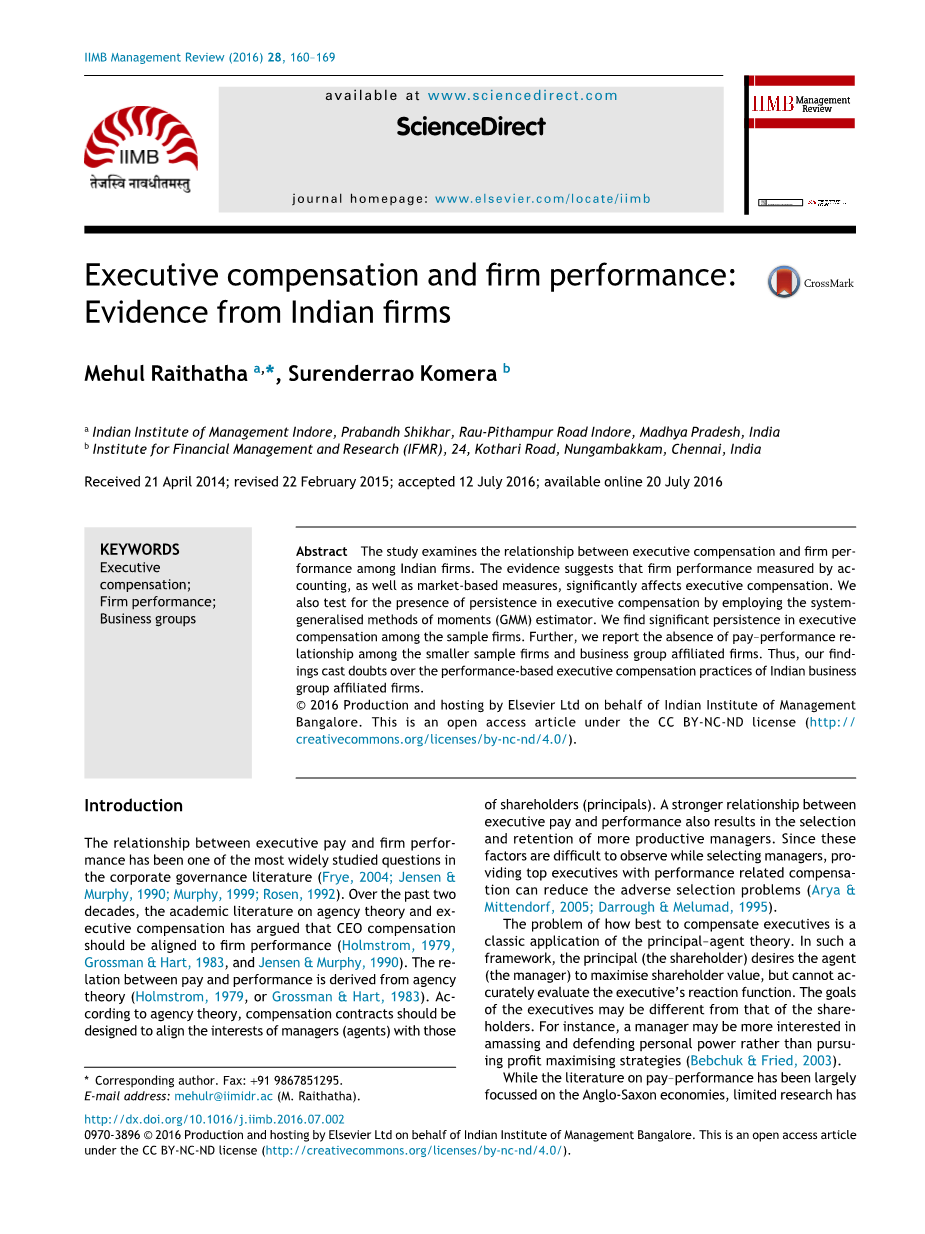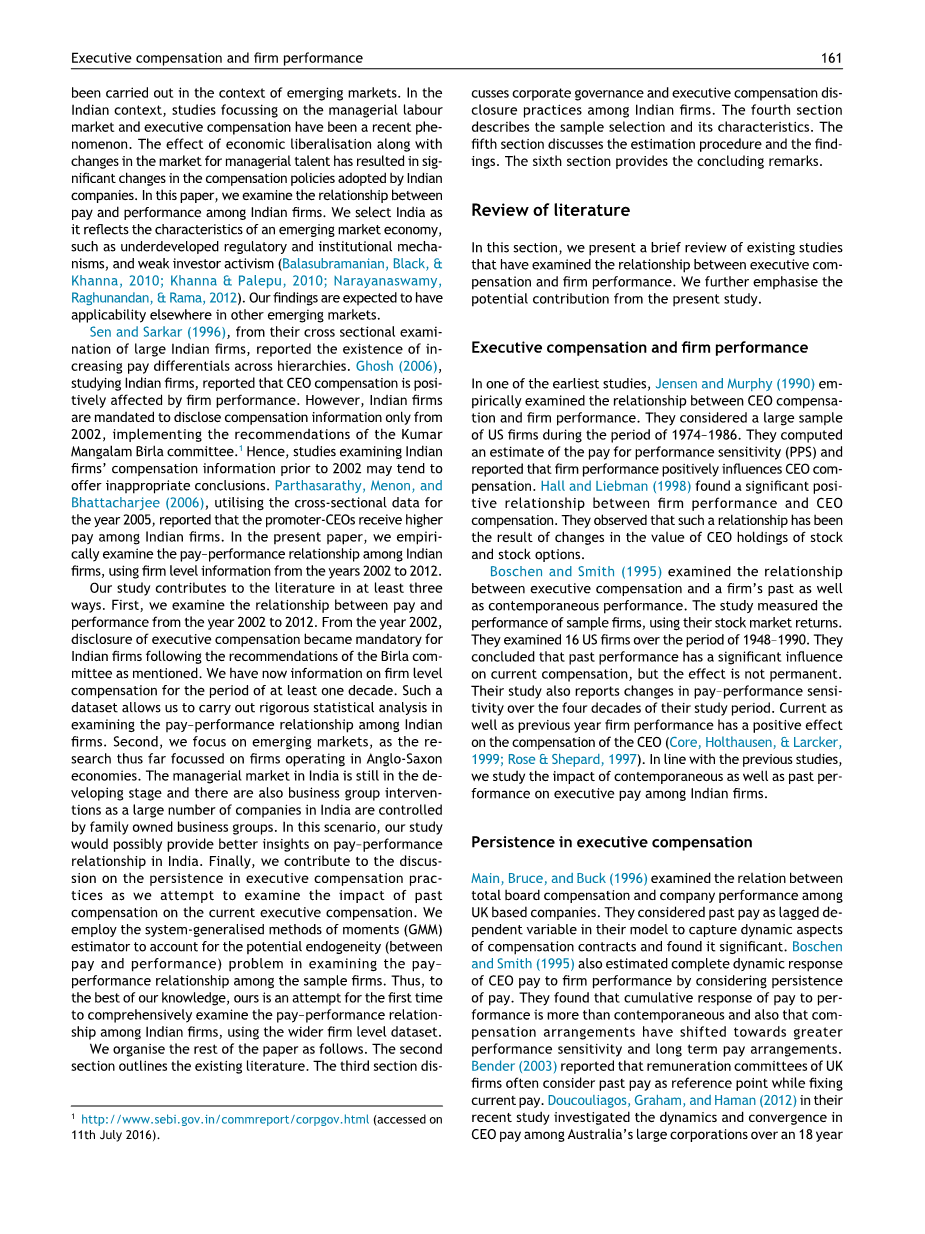

英语原文共 10 页,剩余内容已隐藏,支付完成后下载完整资料
高管薪酬与企业绩效:来自印度企业的
Executive compensation and firm performance: Evidence from Indian firms
Abstract
The study examines the relationship between executive compensation and firm performance among Indian firms. The evidence suggests that firm performance measured by accounting, as well as market-based measures, significantly affects executive compensation. We also test for the presence of persistence in executive compensation by employing the system-generalised methods of moments (GMM) estimator. We find significant persistence in executive compensation among the sample firms. Further, we report the absence of pay–performance relationship among the smaller sample firms and business group affiliated firms. Thus, our findings cast doubts over the performance-based executive compensation practices of Indian business group affiliated firms.
Keywords
Executive compensation
Firm performance
Business groups
Introduction
The relationship between executive pay and firm performance has been one of the most widely studied questions in the corporate governance literature (Frye, 2004; Jensen amp; Murphy, 1990; Murphy, 1999; Rosen, 1992). Over the past two decades, the academic literature on agency theory and executive compensation has argued that CEO compensation should be aligned to firm performance (Holmstrom, 1979, Grossman amp; Hart, 1983, and Jensen amp; Murphy, 1990). The relation between pay and performance is derived from agency theory (Holmstrom, 1979, or Grossman amp; Hart, 1983). According to agency theory, compensation contracts should be designed to align the interests of managers (agents) with those of shareholders (principals). A stronger relationship between executive pay and performance also results in the selection and retention of more productive managers. Since these factors are difficult to observe while selecting managers, providing top executives with performance related compensation can reduce the adverse selection problems (Arya amp; Mittendorf, 2005; Darrough amp; Melumad, 1995).
The problem of how best to compensate executives is a classic application of the principal–agent theory. In such a framework, the principal (the shareholder) desires the agent (the manager) to maximise shareholder value, but cannot accurately evaluate the executive#39;s reaction function. The goals of the executives may be different from that of the shareholders. For instance, a manager may be more interested in amassing and defending personal power rather than pursuing profit maximising strategies (Bebchuk amp; Fried, 2003).
While the literature on pay–performance has been largely focussed on the Anglo-Saxon economies, limited research has been carried out in the context of emerging markets. In the Indian context, studies focussing on the managerial labour market and executive compensation have been a recent phenomenon. The effect of economic liberalisation along with changes in the market for managerial talent has resulted in significant changes in the compensation policies adopted by Indian companies. In this paper, we examine the relationship between pay and performance among Indian firms. We select India as it reflects the characteristics of an emerging market economy, such as underdeveloped regulatory and institutional mechanisms, and weak investor activism (Balasubramanian, Black, amp; Khanna, 2010; Khanna amp; Palepu, 2010; Narayanaswamy, Raghunandan, amp; Rama, 2012). Our findings are expected to have applicability elsewhere in other emerging markets.
Sen and Sarkar (1996), from their cross sectional examination of large Indian firms, reported the existence of increasing pay differentials across hierarchies. Ghosh (2006), studying Indian firms, reported that CEO compensation is positively affected by firm performance. However, Indian firms are mandated to disclose compensation information only from 2002, implementing the recommendations of the Kumar Mangalam Birla committee.1 Hence, studies examining Indian firms#39; compensation information prior to 2002 may tend to offer inappropriate conclusions. Parthasarathy, Menon, and Bhattacharjee (2006), utilising the cross-sectional data for the year 2005, reported that the promoter-CEOs receive higher pay among Indian firms. In the present pape
全文共73394字,剩余内容已隐藏,支付完成后下载完整资料
资料编号:[10019],资料为PDF文档或Word文档,PDF文档可免费转换为Word


